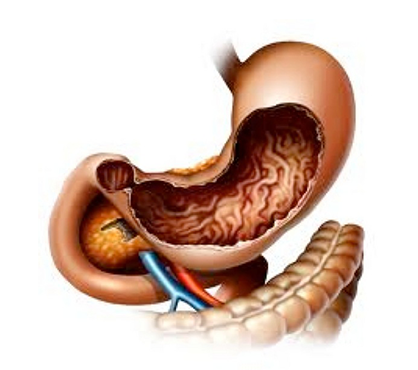Gastritis
 Overview
Overview
When the stomach lining has an acute or chronic inflammation, the resulting condition is known as gastritis. Typically, this happens and causes only mild symptoms. The symptoms can vary depending on the cause of the irritation.
The cases caused by ulcers tend to be more severe and have worse symptoms. This condition can also cause abdominal bloating, belching, nausea and vomiting, as well as sensations of burning or fullness in the upper abdomen. Severe cases can lead to serious bleeding, which can also result in blood in the individual's stools or vomit.
Causes
Gastritis is most commonly caused by an infection of Heliobacter pylori bacteria, which is also the primary cause of ulcers. Other things that can cause gastritis include drinking too much alcohol, smoking and the long-term use of non-steroidal anti-inflammatory drugs (NSAIDs) such as ibuprofen and aspirin. Gastritis is also known to develop after severe stresses such as an injury or major surgery, burns or serious infections.
Other diseases such as pernicious anaemia, Crohn's disease, autoimmune disorders, and chronic bile reflux can cause gastritis. This condition can also be an effect of radiation treatments for cancer.
Prevention
Gastritis can sometimes be prevented by avoiding alcohol and smoking. For people who need to take corticosteroids or anti-inflammatory medications over long periods of time, it is imperative to learn from a physician how to guard the stomach against damage.
It may help to avoid foods that prove irritating to the stomach lining, such as those that are fatty or spicy, as well as very acidic foods or drinks.
Diagnosis
This condition can be diagnosed in various ways, including a stool test that will detect blood in the stool. Other tests include breath tests, biopsies and cultures which can detect the prsence of H. pylori bacteria in the digestive tract. Blood tests can reveal low red blood cell counts, which are also indicative of anaemia caused by bleeding.
An upper GI series of X-rays may be called for, along with endoscopic exams of the stomach. During this test, a thin, flexible tube with a light and camera on its tip is passed down through the throat into the stomach to take images. The tube can also obtain tissue specimens for biopsy or cultures.
Who is at Risk?
Those people at risk include individuals who:
- Are over the age of 60
- Abuse alcohol
- Smoke
- Have pernicious anaemia
- Undergo radiation treatments
- Are long-term users of NSAIDs
- Have digestive disorders
- Are stricken with lymph system diseases
- Have experienced severe stress, such as a head injury, surgery, respiratory problems or organ failure
Treatment
Changes in diet and lifestyle can help to relieve gastritis, and the use of medication may cure it. Important steps in controlling gastritis are to give up smoking and alcohol, as both irritate the stomach and can lead to further inflammation.
Avoid fatty, spicy and acidic foods until the condition is healed. some people should also avoid citrus foods, caffeine and black tea.
Some individuals find sipping warm drinks help soothe the stomach. There may be a desire to drink warm, sweetened milk, which soothes digestive discomfort and uneasiness.
Because many people suffering from this condition experience a loss of appetite, it may help to eat several small meals throughout the day to try to avoid irritating the mucosa.
Drinking plenty of water and other bland liquids can help preven dehydration during this condition. Eat food that is well cooked and easily digested. For acute cases of this disease, soft foods such as rice porridge or chicken soup are good choices.
Natural treatments to try include:
- Probiotics to heal the mucosa and help antibiotics work more effectively
- 500 mg of mastic gum three times a day
- Drinking 3 cups of fresh chamomile tea daily
- Slippery elm
- Eating soluble fibre such as oats, oat bran, dried beans and peas, barley, apples and flax seeds
- Herbs, including licorice, marshmallow, plantain, ribwort, coltsfoot and Irish moss.
References
- Bratman, S. The Alternative Medicine Ratings Guide: an expert panel rates the best treatments for over 80 conditions, Prima Health A Division of Prima Publishing (1998)
- Brown, L. Alternative Medicine, NTC/Contemporary Publishing (1999)
- Deepak Chopra, M.D. Alternative Medicine: The Definitive Guide, Celestial Arts (2002)
- Servan-Schreiber, D. The Encyclopedia of New Medicine: Conventional & Alternative Medicine For All Ages, Rodale International Limited (2006)
Posted in Gastritis
Ask a Question Or Join a Discussion


